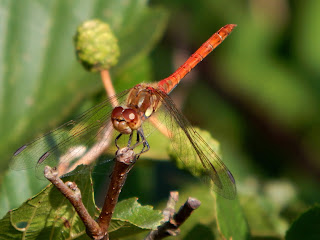I went to Birdfair once, it was OK if you like that sort of thing, unfortunately I wasn't that grabbed by the whole shindig and have yet to return. So it was that once again I shunned the big event and chose to hit Priors Hall instead where I hoped to catch up with some interesting wildlife.
 |
| Young Dabchick at the A43 pond. |
On my way there I stopped at the A43 pond in Weldon where the family of Tufted Ducks appear to be doing rather well. The Mute Swan is still present and I also found a young Dabchick. Lots of yucky eclipse Mallards around too, a more dedicated soul may have looked through them for a Gadwall but not me. First butterfly of the day was seen here, a Speckled Wood, while a sheltered and sunny spot held several Common Darters.
 |
| Speckled Wood revealing that striking underwing pattern. |
At Priors Hall the lake was all but devoid of birds beyond the mundane stuff apart that is from a Common Sandpiper. A Sparrowhawk flew low across the quarry hoping to ambush some unfortunate bird but was not in view long enough to check on any success. A Common Blue butterfly, the first of many, was flushed as I headed towards the ponds. Other species soon followed, Small Heath and Brown Argus the most interesting perhaps but Small Whites were present too.
 |
| Male Migrant Hawker. |
Around the first two ponds both species of darters were found and there were small numbers of both Blue-tailed and Common Blue damsels. Reed Warblers continue to chack from within the cover of the vegetation while parties of hirundines hunted overhead. A male Migrant Hawker posed beautifully here, I must have taken over thirty pictures of him.
 |
| Common Darters. |
Walking up alongside the alders on my way to the other ponds I had the first of seven sightings of Clouded Yellow. They are drawn to a huge area of open ground covered in thistles and sow thistles and one was good enough to pose for a piccy. It was in this area that I flushed a Brown Hare which was my first here for quite a while.
 |
| Better late than never, a Clouded Yellow. |
 |
| Another Emerald Damselfly, what can I say, I like them. |
Another Common Lizard following on from last week's sightings showed briefly and there were several sightings of froglets too. The ponds set in the alders held several patrolling male Migrant Hawkers and there were Emerald Damsels on three ponds. Lots of mating activity amongst the Common Darters whereas the Ruddies seemed more interested in making war. Butterflies were in fairly short supply with a few Gatekeepers and a single Meadow Brown being recorded. I was able to add Green-veined and Large White to the day list and they joined Peacock, Comma, Small Tort and Red Admiral on the list. One feature of today was the number of Speckled Woods, I can't recall seeing them in such numbers before.
 |
| Redstart. |
While walking along a hedge line I heard a familiar call and a quick scan with the bins revealed a Redstart. This is only my second Autumn record of what remains a very scarce passage migrant around here and was a welcome find. A Yellow Wagtail close to one of the other ponds was also appreciated. Passing the two largest ponds added Emperor, Brown and Southern Hawker to the day's tally. After that it was off home with no sense that I had missed out by giving a certain birdy gathering the old heave ho.
 |
| A very lucky Gatekeeper by the looks of it. |



















































